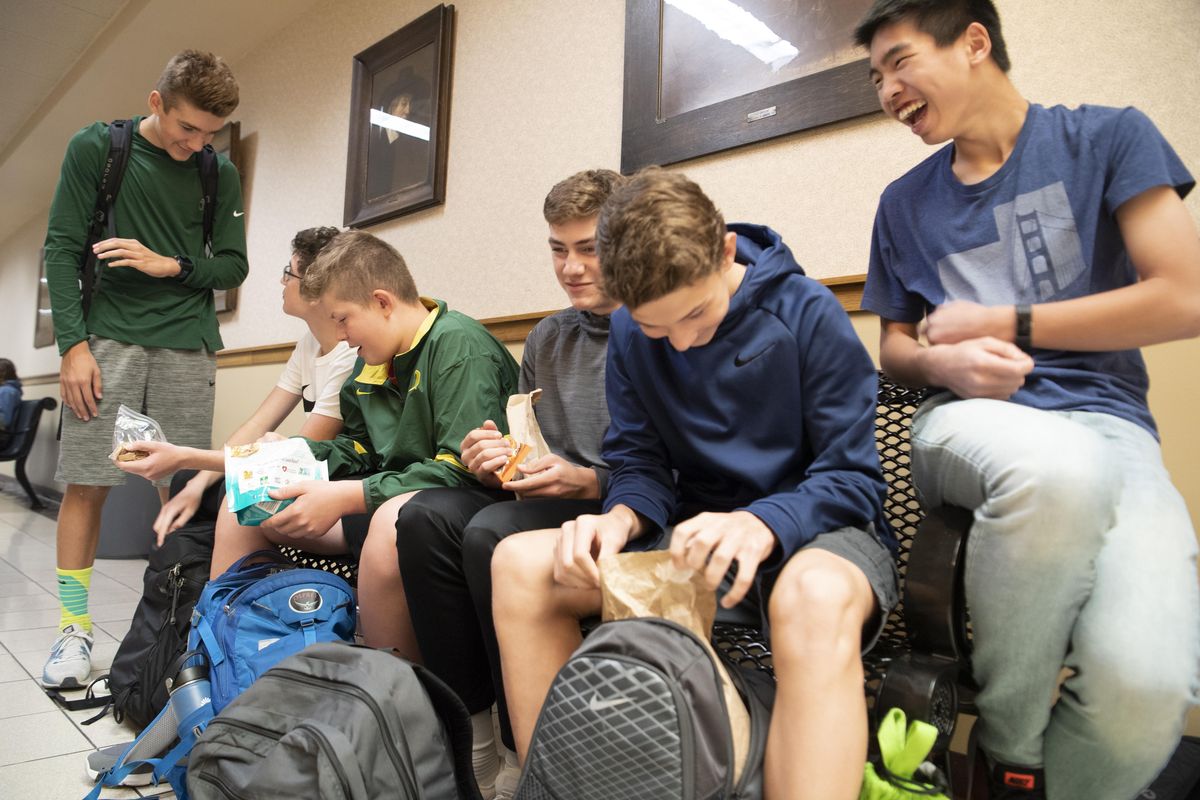Passage of Spokane Public Schools bond would ease Lewis and Clark’s lunchtime chaos

At Lewis and Clark High School, the lunchtime experience is what you make it.
Depending on the student, it could be a burger in the band room, nachos on the stairs with friends or a slice of pizza on the grass next to the historic building that’s home to 2,000 students.
For others, it’s takeout on Third Avenue, where the rush hour hits at 11 a.m. as LC students fill McDonald’s and other fast-food joints.
Some call it freedom, but it comes at the price of peace of mind for Principal Marybeth Smith and parents who hope that their children don’t stray into danger.
“It’s a challenge,” said Smith, who oversees the only open high school campus in the city. “You worry about young kids and the safety issues of being out unsupervised.”
However, a safer lunch experience – with a closed campus – is part of the smorgasbord that Spokane Public Schools is serving up to voters on Nov. 6.
In addition to six middle school buildings and other improvements, the $495 million bond includes $18 million for a new cafeteria-commons area at LC. If the bond wins approval from at least 60 percent of Spokane voters, the 10,500-square-foot building would sit on open land west of the school.
More than a place to eat, it would serve as a focal point for the LC community.
“When you send a team to state, where do you celebrate?” asked Smith.
The answer: with a giant gong in the hallway.
“It’s pretty cool,” Smith said. “The kids line up in the hall and bang it, but only the kids who can crowd into the front of the hall can actually see it.”
“Other schools get together, bring out microphones and play music – we want to be a part of that,” said Smith, who wants to see a central location for more school activities.
That’s important for a school that is “dissected and bisected” by arterials, as Smith said on Aug. 1, when the school board put the bond on the ballot.
“Tiger Nation really needs a commons area,” said Smith, who started her LC career as a teacher in 1984.
So why hasn’t that happened at school that’s been around since 1912? Because it’s always been done that way. When the major restoration of LC began in 1999, a commons-cafeteria barely came up in the discussion, according to Smith.
She respects the tradition, which includes a single lunch period for 2,000 students. “A lot of people who’ve graduated will say that was one of the biggest things they like.”
For many, it still is.
“It’s more freedom this way,” said sophomore Annabelle Church, who last Tuesday was eating nachos in a school stairwell with friends. “Pretty much everybody prefers this over a regular cafeteria because you can hang out and go wherever you want.”
But while freshmen and sophomores are required to stay on campus, upperclassmen are allowed to roam – under the Interstate 90 overpass and toward the row of fast-food restaurants on Third Avenue and beyond.
At the same time, four LC girls were walking past a group of older men and toward the Crosswalk shelter at Second Avenue and Howard Street.
Meanwhile, about a dozen teens were downing fast food in the shadow of the freeway offramp as homeless people walked nearby.
According to some, the problem is worse than that. Underclassmen must wear lanyards that distinguish them as such, but some sneak off campus anyway.
“Tons of (underclass) kids go off campus,” said sophomore Nathanyel Schmidt. “At the very beginning of the year, they try to scare the kids and tell them that you have to show ID to get back in,” Schmidt said, but he added that it’s easy to re-enter.
“It’s cool that people can go off campus, but it’s not a good setup because it lets people wander all over town,” Schmidt said.
The campus is “very porous,” Smith admitted.
‘The chicken in every pot’
The LC commons-cafeteria project is one of many single-school improvements contained in the bond.
“It’s the chicken in every pot,” as associate superintendent Mark Anderson described dozens of smaller projects that would take place during the life of the bond.
The new bond contains $14 million for technology and security upgrades, which comes on top of the $15 million still in the bank from the current bond that was approved in 2015.
The district has allocated $4 million to improve point-of-entry at all schools, and has employed a national consulting firm for a fire and security audit, Anderson said.
That audit will produce recommendations for added security, Anderson said. The cost will be borne by the new bond; or, if the latter is rejected, from the district’s general fund.
According to district policy, smaller districtwide capital improvements are approved as deemed necessary by the district’s board of directors.